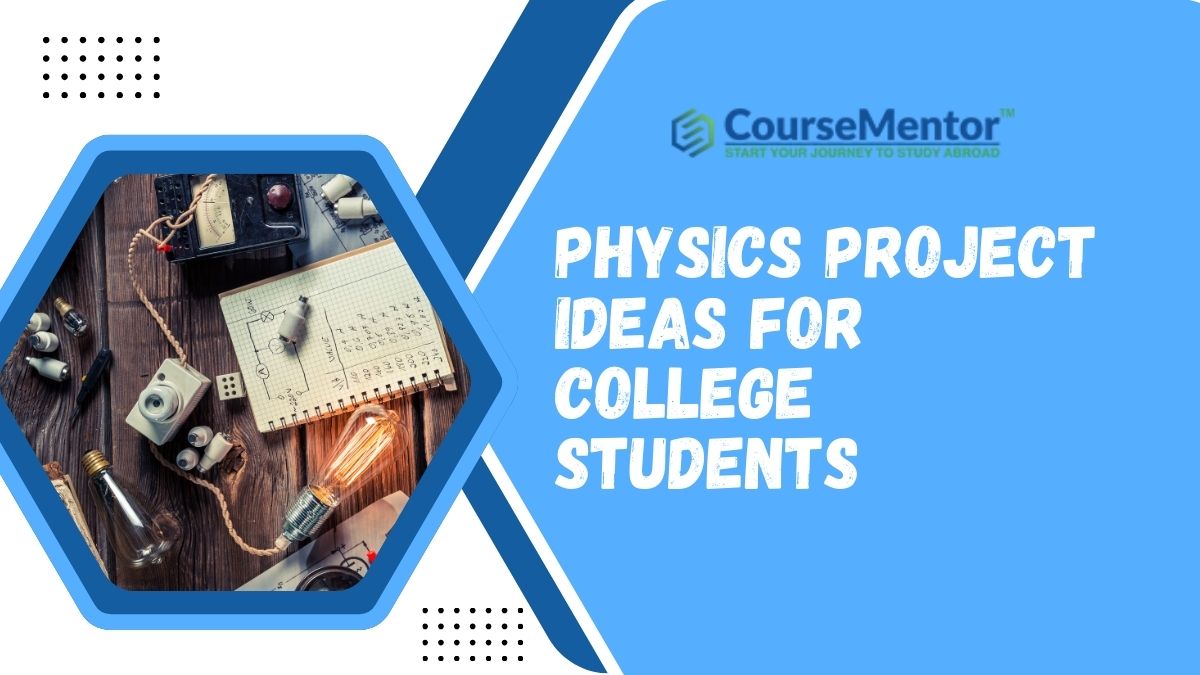Energize your college experience with physics project ideas for college students. Explore intriguing experiments and projects to fuel your scientific curiosity and academic journey.
In the dynamic realm of physics, knowledge is not confined to textbooks and lectures alone. It thrives when theory meets experimentation, and this intersection is where college students can truly explore and appreciate the wonders of the physical world.
Physics projects offer a remarkable avenue to bridge the gap between theoretical understanding and practical application, fostering a deeper grasp of scientific concepts and igniting a passion for discovery.
As college students embark on their academic journeys, engaging in physics projects presents an opportunity to go beyond the classroom, delve into fascinating experiments, and uncover the intricate laws that govern our universe.
These projects not only bolster academic growth but also encourage creativity, critical thinking, and problem-solving skills.
This guide is your gateway to a world of captivating physics project ideas tailored to the college level.
The Art of Choosing a Physics Project
Here’s a list of steps that encompass “The Art of Choosing a Physics Project”:
Identify Your Interests
Begin by reflecting on your personal interests within the field of physics. Are you fascinated by optics, electromagnetism, or perhaps quantum physics? Identifying your passion will lead you in the right direction.
Consider Your Academic Goals
If you’re a college student, think about how your project can complement your coursework. Is there a specific area of physics that aligns with your academic goals or major?
Assess Your Skill Level
Be realistic about your current knowledge and skills in physics. Choose a project that matches your expertise. For beginners, simple experiments may be more appropriate, while advanced students can take on more complex challenges.
Consult with Professors or Mentors
Seek guidance from your professors or mentors. They can provide valuable insights and suggest project ideas that align with your academic or career aspirations.
Explore Resource Availability
Consider the availability of resources and equipment. Some projects may require specialized tools or materials that may not be readily accessible.
Define Your Project Scope
Clearly outline the scope of your project. What specific aspect of physics are you investigating? What are your research questions and objectives?
Align with Your Budget
If your project has budget constraints, make sure your chosen project is financially feasible. There are plenty of low-cost physics experiments that can be just as enlightening.
Review Existing Research
Familiarize yourself with existing research and projects in your chosen area. This will help you build upon existing knowledge and potentially identify gaps to explore.
Consider the Timeframe
Determine the timeline for your project. Ensure that it aligns with your academic schedule and available time for research and experimentation.
Passion and Curiosity
Ultimately, choose a project that genuinely excites your curiosity and passion. A project you’re enthusiastic about will be more rewarding and enjoyable to work on.
Remember that selecting the right physics project is a crucial first step, setting the stage for an engaging and meaningful journey through the world of physics.
Physics Project Ideas for College Students
Check out physics project ideas for college students:-
Optics and Light
- Investigate the behavior of light in different colored filters.
- Construct a simple pinhole camera and explore its principles.
- Study the refraction of light through different liquids.
- Create a periscope and understand how it works.
- Explore the formation of images in concave and convex mirrors.
- Investigate the polarization of light.
- Analyze the physics of optical illusions.
- Study the properties of fiber optics in data transmission.
- Create a laser light show and explain the optics behind it.
- Build a spectrometer to analyze the spectra of various light sources.
Electromagnetism
- Investigate the effect of temperature on electrical conductivity.
- Create a model of Faraday’s electromagnetic induction experiment.
- Study the behavior of magnetic fields using iron filings.
- Explore the principles of electromagnetic waves and their applications.
- Investigate the physics of magnetic levitation (Maglev) systems.
- Build a Gauss rifle to demonstrate the principles of electromagnetic acceleration.
- Analyze the behavior of superconductors in the presence of magnetic fields.
- Explore the concept of eddy currents in conductive materials.
- Create a simple radio transmitter and receiver for wireless communication.
- Construct a simple electromagnetic generator and measure the induced voltage.
Mechanics
- Explore the physics of fluid dynamics using a Bernoulli’s principle experiment.
- Analyze the forces involved in a bungee jumping model.
- Study the physics of harmonic motion with a pendulum clock.
- Investigate the behavior of a gyroscope and its stability.
- Explore the physics of projectile motion with a catapult experiment.
- Analyze the principles of energy conservation with a roller coaster model.
- Investigate the physics of friction and surface materials.
- Explore the impact of air resistance on falling objects.
- Create a mechanical model of a simple harmonic oscillator.
- Investigate the conservation of angular momentum with a rotating platform.
Thermodynamics
- Explore the properties of phase transitions and latent heat.
- Analyze the behavior of ideal gases under varying conditions.
- Investigate the principles of heat conduction in different materials.
- Study the thermodynamic processes involved in a refrigeration cycle.
- Explore the physics of heat exchangers and their applications.
- Investigate the behavior of gases at low temperatures using cryogenics.
- Analyze the principles of thermoelectric generators and their efficiency.
- Create a simple solar water heater and study its heat transfer efficiency.
- Investigate the physics of phase diagrams and phase equilibria.
- Investigate the efficiency of different types of heat engines.
Modern Physics
- Investigate the behavior of particles in a cloud chamber.
- Analyze the principles of nuclear decay and radiation detection.
- Study the physics of particle accelerators and their applications.
- Investigate the properties of quantum tunneling and its practical significance.
- Explore the principles of wave-particle duality with a double-slit experiment.
- Investigate the physics of quantum cryptography and its security features.
- Analyze the properties of superconductors and their applications.
- Study the behavior of quantum entanglement through a Bell test experiment.
- Investigate the physics of quantum computing with a simple quantum circuit.
- Explore the photoelectric effect and determine Planck’s constant.
Astrophysics
- Investigate the properties of exoplanets and their detection methods.
- Analyze the spectral lines of different stars for their compositions.
- Study the dynamics of galaxies and their rotations.
- Investigate the expansion of the universe and measure the Hubble constant.
- Explore the principles of gravitational lensing in space observations.
- Investigate the physics of cosmic microwave background radiation.
- Study the characteristics of black holes and their effects on nearby stars.
- Analyze the formation and evolution of star clusters.
- Create a simple radio telescope to detect celestial radio waves.
- Observe and track the motion of a specific celestial object over time.
Acoustics and Sound
- Study the Doppler effect with sound waves and moving sound sources.
- Analyze the acoustic properties of different musical instruments.
- Investigate the physics of sound reflection with a soundproofing experiment.
- Explore the behavior of standing waves in musical instruments.
- Investigate the properties of different acoustic materials for sound insulation.
- Study the physics of ultrasonic cleaning and its applications.
- Analyze the principles of sound amplification using simple sound systems.
- Investigate the physics of noise-canceling technology in headphones.
- Investigate the principles of resonance with vibrating strings and tubes.
- Create a musical water fountain to explore the interaction of water and sound waves.
These diverse physics project ideas offer a wide array of options for college students to delve into the fascinating world of physics and conduct hands-on experiments in their chosen areas of interest.
The Practical Side of Physics Projects
Here’s a list of practical aspects that encompass “The Practical Side of Physics Projects”:
Gathering Materials and Equipment
Identify and acquire all the necessary materials and equipment required for your physics project. This includes everything from specialized tools to everyday items like rulers and thermometers.
Creating a Detailed Experimental Setup
Design a clear and organized experimental setup. This setup should include the positioning of equipment, tools, and any safety precautions. A well-structured setup is essential for the accuracy and reproducibility of your experiments.
Setting Up the Apparatus
Carefully arrange and assemble the experimental apparatus, making sure it aligns with the project’s objectives. This step may involve calibrating instruments, connecting wires, or arranging optical components.
Ensuring Safety Measures
Prioritize safety throughout the setup process. Double-check that all equipment is functioning correctly and safely. Use personal protective gear where necessary, and be aware of any potential hazards associated with your experiments.
Establishing Measurement Protocols
Define precise measurement protocols for your project. This includes outlining the units of measurement, ensuring the calibration of instruments, and understanding the accuracy of measurements.
Conducting Controlled Experiments
Execute your experiments systematically, following your pre-established procedures. Maintain a thorough record of all data and observations, documenting everything accurately.
Recording Observations
Record your observations and data in an organized and structured manner. Ensure that all measurements are accompanied by the relevant experimental conditions and parameters.
Addressing Variables
Be conscious of any variables that might affect your experiments. These can include environmental conditions, fluctuations in voltage, or variations in materials. Minimize these variables where possible to ensure the reliability of your data.
Maintaining a Lab Notebook
Keep a well-organized lab notebook. This should include detailed records of experimental setups, observations, measurements, and any unexpected findings. A comprehensive notebook is invaluable for the analysis and presentation of your results.
Ensuring Data Reproducibility
Pay attention to the reproducibility of your experiments. Make sure that another person following your procedures could obtain similar results. This is a fundamental aspect of scientific rigor.
Safety Precautions
Adhere to safety precautions at all times during experiments. This includes using appropriate protective equipment, handling chemicals with care, and following best practices for laboratory safety.
Data Backups
Regularly back up your data, either in hard copies or electronic formats. This prevents data loss in case of unexpected events like equipment malfunction or accidental data deletion.
Troubleshooting
Be prepared to troubleshoot any issues that may arise during experiments. Familiarize yourself with common problems in your chosen area of physics and how to resolve them.
Adaptability
Be flexible and adaptable in your approach. Sometimes, unexpected results or changes in experimental conditions can lead to new insights or avenues of exploration.
Data Integrity
Maintain the integrity of your data by avoiding data manipulation or bias. Honest and accurate data representation is a fundamental ethical responsibility in scientific research.
These practical considerations are essential for the successful execution of physics projects, ensuring that experiments are safe, accurate, and reliable.
The Future of Physics Projects
The future of physics projects is nothing short of exciting. There’s a world of new research areas waiting to be explored, and the constant stream of emerging technologies promises to unlock innovative experiments we haven’t even dreamed of yet.
Let’s take a closer look at some of the thrilling trends shaping the future of physics projects:
The Data Deluge
Physics experiments are churning out data at an unprecedented rate. It’s like opening a treasure chest of insights into the universe. However, this also means we need clever solutions for storing and analyzing this mountain of data efficiently.
Tech Marvels
Physics is in the midst of a tech revolution. Imagine artificial intelligence, machine learning, and quantum computing joining forces to create mind-boggling tools for research. T
his tech wizardry has the potential to turn the way we do physics on its head.
Global Physics Party
Physics knows no borders. Scientists from around the globe are throwing a colossal party of knowledge-sharing and discovery.
They’re teaming up on massive projects like the Large Hadron Collider and the International Space Station, creating a melting pot of fresh and brilliant ideas.
With these trends in play, the future of physics projects is like a cosmic playground, where every experiment could unearth the next big discovery.
It’s a future where the universe’s secrets are waiting to be unraveled, one project at a time.
What should I make for my physics project?
When it comes to selecting the ideal physics project, it’s a decision that should be made considering your interests, skills, and available resources.
Striking the right balance between a challenge and achievability is key. Here are some physics project ideas to explore:
Solar-Powered Car
Constructing a solar-powered car is an engaging venture that delves into solar energy, electric motors, and gear mechanisms. It’s a rewarding challenge.
Model Rocket
The creation of a model rocket is not only fun but also highly educational. This project offers insights into aerodynamics, propulsion, and the dynamics of flight.
Water Clock
A water clock, with its simplicity and elegance, provides a hands-on exploration of water’s distinctive properties.
Newton’s Cradle
This classic physics experiment is a captivating showcase of the principles of momentum and energy conservation.
Cloud Chamber
A cloud chamber, a truly fascinating device, allows you to visualize the tracks left by charged particles as they traverse through a gas medium.
Foucault Pendulum
Building a Foucault pendulum presents a captivating demonstration of the Earth’s rotation and its dynamic characteristics.
These are just a few initial ideas, with a vast realm of physics projects awaiting your exploration. Once you’ve made your selection, delve into some research to deepen your understanding of the chosen topic and develop a comprehensive plan for your project.
What is the easiest experiment to do on a physics project?
Determining the easiest physics experiment for your project hinges on your interests and available resources. However, if you’re seeking generally straightforward physics experiments, consider the following:
Newton’s Cradle
This experiment vividly illustrates the principles of momentum and energy conservation in a simple setup. You can create a Newton’s cradle using basic materials like metal balls, string, and a support stand.
Balloon Rocket
For a fun and enlightening exploration of aerodynamics, propulsion, and flight dynamics, the balloon rocket experiment is an exciting choice. All you need are common materials like a balloon, string, and a launch pad.
Water Clock
To delve into the properties of water in an elegant manner, a water clock experiment is both simple and informative. Gather materials such as two plastic bottles, tubing, and water to create this project.
Pendulum Wave Toy
Explore the fascinating world of waves and pendulums with a pendulum wave toy. This project can be assembled using basic items like string, a weight, and a supporting stand.
Dancing Rice
This experiment effectively showcases the principles of friction and vibration. With minimal materials like rice, a speaker, and a piece of paper, you can bring this engaging experiment to life.
These suggestions offer accessible options for physics experiments. When making your choice, consider your personal interests, skills, available resources, and safety precautions.
Select an experiment that aligns with your project’s time constraints, ensuring a successful and enriching experience.
What are some cool physics experiments?
Here are some captivating physics experiments that you can perform either at home or in a school lab:
Levitating Ball
Utilizing a magnet and a current-carrying coil, this experiment generates a magnetic field that seemingly defies gravity and levitates a ball.
Plasma Globe
This experiment uses a high-voltage transformer to create a mesmerizing plasma ball—a radiant, spherical display of glowing plasma.
Jacob’s Ladder
By employing two electrodes and a high-voltage power supply, this experiment produces a visually striking electric arc that gracefully climbs between the electrodes.
Tesla Coil
With a high-frequency transformer, you can construct a Tesla coil, capable of producing captivating high-voltage sparks and mesmerizing lightning bolts.
Gyroscope
A spinning wheel takes center stage in this experiment, offering a hands-on demonstration of the fundamental principles of angular momentum and gyroscopic precession.
Air Hockey Table
By harnessing the power of a fan, this experiment creates an air cushion that allows a puck to glide effortlessly over the table’s surface, emulating the excitement of an air hockey game.
Wind Tunnel
Employing a fan, you can transform your space into a wind tunnel, perfect for studying the intriguing effects of airflow on various objects.
Rube Goldberg Machine
This creative experiment presents a chain reaction machine designed to execute a simple task in a whimsical, complex, and entertaining manner.
These experiments offer a range of exciting physics experiences. When selecting one for your project, take into account your personal interests, skill level, and the resources at your disposal.
Additionally, prioritize safety and ensure that the experiment can be completed within your project’s time constraints.
What can you build with physics?
Physics, at its essence, is the science that explores the behavior of matter in the context of space and time.
It encompasses the intricate relationships of energy and force, rendering it one of the most fundamental sciences.
Its applications ripple across a multitude of domains, including engineering, technology, and medicine.
Consider the wide-ranging spectrum of innovations rooted in physics:
Machines
From elementary tools like levers and pulleys to complex marvels such as cars, airplanes, and computers, physics serves as the blueprint for creating the machinery that propels our world.
Structures
Whether erecting towering skyscrapers, sturdy bridges, or venturing into the celestial sphere with satellites and spacecraft, physics provides the architectural framework for constructing the foundations of our contemporary society.
Devices
In the realm of healthcare, physics births devices like MRI machines and pacemakers. In communication, it fuels the innovation behind cell phones and computers, enriching our lives.
Processes
Physics extends its reach into pioneering novel processes and technologies, including the harnessing of nuclear power, the embrace of solar energy, and the development of lasers, shaping the trajectory of progress.
In a nutshell, physics stands as the unspoken architect behind the construction of grand edifices and ingenious contrivances, forming the cornerstone of our modern way of life.
Conclusion
In wrapping up, the world of physics project ideas for college students is like an exciting journey through the universe’s wonders.
It’s not just about formulas and experiments; it’s about the thrill of discovery and hands-on learning that will leave a lasting mark on your academic and professional path.
As you dive into your chosen project, keep in mind that the most rewarding ones are those that genuinely captivate your interest.
Don’t hesitate to roll up your sleeves, whether you’re peering through lenses, untangling the mysteries of electromagnetism, or plunging into the quantum abyss.
These projects are not just academic exercises; they’re gateways to understanding the profound laws governing our reality.
While you tackle your project, embrace the challenges. It’s in overcoming these challenges that true learning takes place. Seek guidance when needed, document your journey meticulously, and share your insights with your fellow learners.
After all, learning is a collective endeavor, and your discoveries can inspire others on their journey of exploration.
Peering into the future, the world of physics projects promises to get even more fascinating. Think quantum computing, space exploration, and groundbreaking sustainable energy solutions.
So, keep that scientific flame burning, stay curious, and continue pushing the boundaries of our knowledge about the universe.
Whether you’re building a DIY spectrometer, unlocking the secrets of quantum entanglement, or fashioning a prototype for sustainable energy, your physics project is your personal contribution to the ever-expanding pool of human knowledge.
It’s your opportunity to be part of something extraordinary and to uncover the universe’s enigmas. So, relish every moment of your physics project journey, and let your curiosity be your guiding star as you explore new horizons.
Frequently Asked Questions
How do I choose the right physics project for me?
Choosing the right project involves aligning your interests and academic goals. Consider topics that intrigue you and match your skill level.
Can I conduct physics projects at home?
Many physics projects can be conducted at home, especially those related to optics, electricity, and thermodynamics. You might need to acquire some materials and equipment.
How can I make my physics project presentation engaging?
To create an engaging presentation, structure your findings logically, use visuals, and explain the significance of your project. Practice your delivery to boost confidence.
What is the future of physics projects?
The future of physics projects is brimming with exciting possibilities. Emerging trends include quantum computing, space exploration, and sustainable energy solutions.
How can I incorporate peer review and feedback into my physics project?
Seek feedback from peers, mentors, or professors to refine your project. Use their input to improve your experiments and presentation. Peer review is a valuable part of the scientific process.





